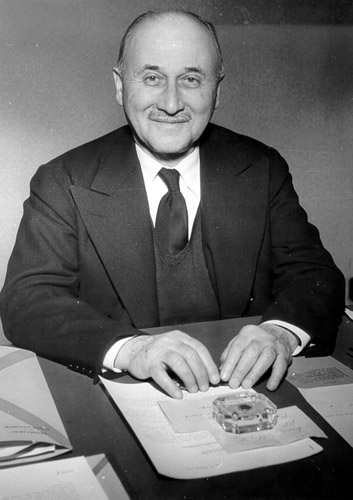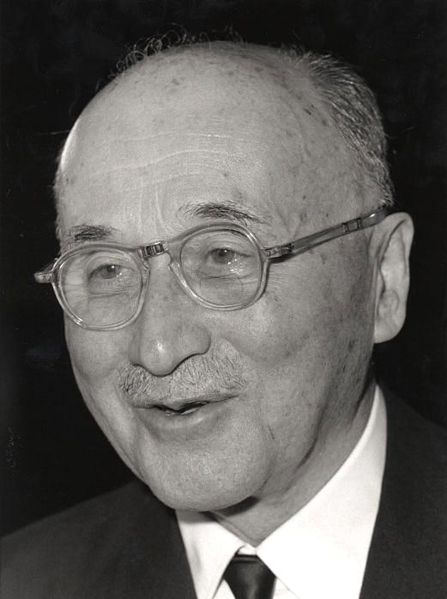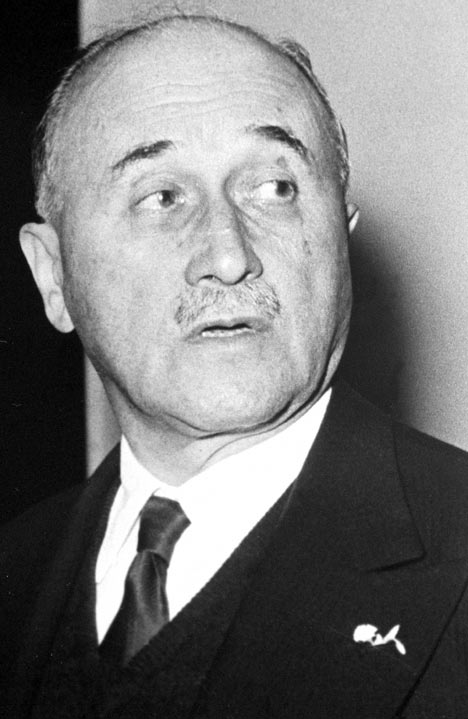<Back to Index>
- President of the High Authority of the ECSC Jean Omer Marie Gabriel Monnet, 1888
PAGE SPONSOR



Jean Omer Marie Gabriel Monnet (9 November 1888 – 16 March 1979) was a French political economist and diplomat. He is regarded by many as a chief architect of European Unity and is regarded as one of its founding fathers. Never elected to public office, Monnet worked behind the scenes of American and European governments as a well connected pragmatic internationalist.
Monnet was born in Cognac, Charente, into a family of cognac merchants. At the age of sixteen, he abandoned his university entrance examinations part way through and moved to London where he spent some years in the City of London with Mr. Chaplin, the agent of his father's company. Subsequently, he traveled widely – to Scandinavia, Russia, Egypt, Canada and the United States – for the family business.
Monnet believed that the only path that would lead to an Allied victory lay in the merging of France and Britain's
war efforts and he reflected on a concept that would co-ordinate war
resources. In 1914, young Monnet was allowed to meet French Premier René Viviani
on this issue. The French government agreed in principle upon his
plans. During the first years of the war Monnet had not much success,
promoting and pressing internationally for a better organization of the
allied economic cooperation. However, finally, stronger combines like
the Wheat Executive (end of 1916) and the Allied Maritime Transport Council (end of 1917) were set into work and had a big share in winning the war.
At the Paris Peace Conference, Monnet was an assistant to the French minister of commerce and industry, Etienne Clémentel, who proposed a "new economic order" based on European cooperation. The scheme was officially rejected by the Allies in April 1919.
Due to his contributions to the war efforts, Monnet, at the age of thirty - one, was named Deputy Secretary General of the League of Nations upon its creation in 1919 by French premier Georges Clemenceau and British statesman Arthur Balfour.
Soon disillusioned with the League because of its laborious unanimous
decision making processes, Monnet resigned in 1923 in order to devote
himself to managing the family business, which was experiencing
difficulties. He returned into international politics and, as an
international financier, he proved to be instrumental in the economic
recovery of several Central and Eastern European nations, helping to stabilize the Polish zloty in 1927 and the Romanian leu in 1928. In 1929, his experience in international finance led him to found and co-manage the Bancamerica - Blair, a bank in San Francisco. From 1934 to 1936, at the invitation of Chiang Kai-shek, Monnet lived in China, assisting with the reorganization of the Chinese railway network.
In December 1939, Monnet was sent to London to oversee the collectivization of British and French war production capacities. Monnet's influence inspired Charles de Gaulle and Winston Churchill to accept a plan for a union of France and the United Kingdom to rival the Pact of Steel alliance between Germany and Italy.
In August 1940, Monnet was sent to the United States by the British Government as a member of the British Supply Council, in order to negotiate the purchase of war supplies. Soon after his arrival in Washington, D.C., he became an advisor to President Franklin D. Roosevelt. Convinced that America could serve as "the great arsenal of democracy" he persuaded the president to launch a massive arms production program to supply the Allies with military material. Shortly thereafter, in 1941, Roosevelt, with Churchill's agreement, launched the Victory Program, which represented the entry of the United States into the war effort. After the war, the British economist John Maynard Keynes was to say that through his co-ordinating Monnet had probably shortened World War II by one year.
In 1943, Monnet became a member of the National Liberation Committee, the would-be French government in exile in Algiers. During a meeting on 5 August 1943, Monnet declared to the Committee:
"There will be no peace in Europe, if the states are reconstituted on the basis of national sovereignty... The countries of Europe are too small to guarantee their peoples the necessary prosperity and social development. The European states must constitute themselves into a federation..."
Following World War II France was in severe need of reconstruction. To rebuild, France was completely dependent on coal from Germany's main remaining coal mining areas, the Ruhr area and the Saar area. (The German coal fields in Upper Silesia had been handed over for "Polish administration" by the Allies in 1945 (Oder - Neisse line).)
In 1945 Monnet proposed the Monnet Plan, also known as the theory of l’engrenage, not to be confused with the Schuman plan, to take control of the remaining coal producing German areas and redirect the production away from German industry and into French industry instead, permanently weakening Germany and raising the French economy considerably above its pre-war levels. The plan was adopted by Charles de Gaulle in early 1946.
In 1947 France, with U.S. support, removed the Saar from Germany and turned it into the Saar protectorate, nominally politically independent and under complete French economic control. The area returned to German political administration in 1957 (economic reunification would take many years longer), but France retained the right to mine from its coal mines until 1981 (The Europeanization of the Saarland).
The Ruhr Agreement was imposed on the Germans as a condition for permitting them to establish the Federal Republic of Germany (International Authority for the Ruhr (IAR)). The IAR controlled production levels, pricing, and to where the output was to be sold, thus ensuring that France received a large portion of the Ruhr coal production at low prices.
With the 1951 German agreement to join the European Coal and Steel Community (the "Schuman Plan") the ongoing Allied dismantling of German industry was finally stopped and some of the restrictions placed on German industrial output were lifted (British foreign ministers' 1949 letter to Schuman).
With the entry into force of the ECSC in 1952 the last civilian production limitations placed on German industry were lifted, and the role of the IAR was taken over by the ECSC (industrial plans for Germany).
As the head of France's General Planning Commission, Monnet was the real author of what has become known as the 1950 Schuman Plan to create the European Coal and Steel Community (ECSC), forerunner of the Common Market.
Following liberation, Monnet proposed a "global plan for modernization and economic development" to the French government. Appointed Planning Commissioner by de Gaulle, he oversaw the revitalization of the French economy. It was from this position that, in 1949, Monnet realized that the friction between Germany and France for control of the Ruhr, the important coal and steel region, was rising to dangerous levels, presaging a possible return to hostilities as had happened after the First World War. Monnet and his associates conceived the idea of a European Community. On 9 May 1950, with the agreement of Chancellor Konrad Adenauer of West Germany, French Minister of Foreign Affairs Robert Schuman made a declaration in the name of the French government. This declaration, prepared by Monnet for Schuman, proposed integration of the French and German coal and steel industries under joint control, a so-called High Authority, open to the other countries of Europe. Schuman declared:
"Through the consolidation of basic production and the institution of a new High Authority, whose decisions will bind France, Germany and the other countries that join, this proposal represents the first concrete step towards a European federation, imperative for the preservation of peace."
Shortly thereafter, West Germany, Italy, Belgium, Luxembourg, and the Netherlands
responded favorably, the European Coal and Steel Community (ECSC) was
born. Britain was invited to participate, but it refused on grounds of
national sovereignty. In 1952, Jean Monnet became the first president of
the High Authority. In 1953 Monnet was awarded the Karlspreis by the city of Aachen in recognition of his achievements.
In 1955, Monnet founded the Action Committee for the United States of Europe in order to revive European construction following the failure of the European Defense Community (EDC). It brought political parties and European trade unions together to become a driving force behind the initiatives which laid the foundation for the European Union as it eventually emerged: first the European Economic Community (EEC) (1958) (known commonly as the "Common Market"), which was established by the Treaty of Rome of 1957; later the European Community (1967) with its corresponding bodies, the European Commission and the European Council of Ministers, British membership in the Community (1973), the European Council (1974), the European Monetary System (1979), and the European Parliament (1979). This process reflected Monnet's belief in a gradualist approach for constructing European unity.
On 6 December 1963, Monnet was presented with the Presidential Medal of Freedom, with Special Distinction, by President Lyndon Johnson. After retiring to his home in Houjarray, Bazoches - sur - Guyonne, Monnet wrote his memoirs.
He died in 1979 at the age of 90. In 1988, by order of the president François Mitterrand, Jean Monnet's remains were transferred to the Panthéon of Paris.
In August 1929, during a dinner party in Paris, the 41 year old Monnet met the 22 year old Italian painter Silvia Giannini (born in Bondini in 1907). She had recently (6 April 1929) married Francisco Giannini, an employee of Monnet when he was a representative in Italy.
In April 1931, Silvia had a child, Anna. Legally, the father was Francisco Giannini.
Divorce was not allowed in France and many other European countries at that time. In 1934, Silvia and Jean Monnet met in Moscow; he had come from China via the Trans - Siberian, she from Switzerland. He arranged for Silvia to obtain Soviet citizenship; she immediately divorced her husband and married Jean Monnet.
The idea for the Moscow marriage came from Dr. Ludwik Rajchman, whom Monnet met during his time at the League of Nations (Rajchman was connected to the Soviet Ambassador to China, Bogomolov). It seems that the American and French ambassadors in Moscow, William Bullitt and Charles Aiphand, also played a role.
The custody of Anna was a problem; in 1935 Silvia took refuge with Anna in the Soviet consulate in Shanghai, where they were living at the time, because Francisco Giannini was trying to obtain custody of the child. The legal battle continued with a ruling in favor of Silvia in 1937 in New York, but this was not recognized in some other countries. In 1941, they had another child, Marianne. The Monnet family returned to France in 1945.
After the death of Francisco Giannini in 1974, they married canonically in the cathedral of Lourdes.
The Jean Monnet Building of the European Commission is named for him.
Several European universities honor Monnet. The University of Limerick, Ireland, has a lecture theater named after him. British educational institutions which honor Monnet include the Jean Monet Centre of Excellence at King's College London, the East Midlands Euro - Centre at Loughborough University, the European Research Institute at the University of Bath, the Jean Monnet Centre at the University of Birmingham, the Jean Monnet European Centre of Excellence at Cambridge, the Jean Monnet European Centre of Excellence at the University of Essex, the Centre for European Union Studies at the University of Hull, the Kent Centre for Europe at the University of Kent, the Jean Monnet Centre of Excellence, a partnership between the University of Manchester, Manchester Metropolitan University and the University of Salford, the Jean Monnet Centre at Newcastle University and the Jean Monnet Centre for European Studies at the University of Wales.
In April 2011, to commemorate the 60th anniversary of the signing of the Treaty of Paris, a new documentary, "Jean Monnet: Father of Europe" was produced. The documentary includes interviews with Monnet colleagues such as Georges Berthoin, Max Kohnstamm, Jacques - René Rabier as well as former member of the European Court of Justice David A.O. Edward of the United Kingdom.
The European Union itself maintains his memory with the Jean Monnet Programme of the Directorate - General for Education and Culture. This aims to promote knowledge on European integration on a worldwide scale, especially at the university level.